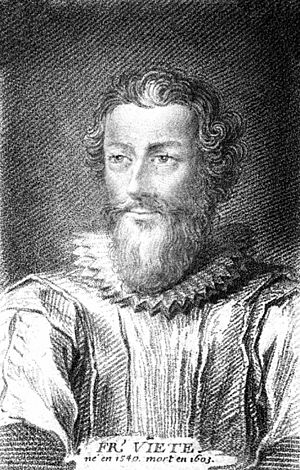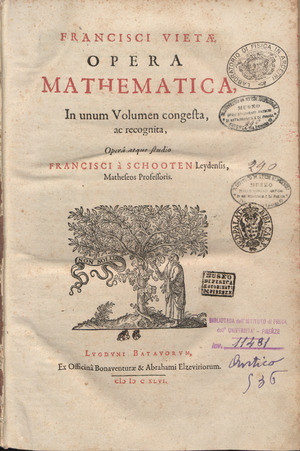François Viète facts for kids
Quick facts for kids
François Viète
|
|
|---|---|
 |
|
| Born | 1540 |
| Died | 23 February 1603 (aged 62–63) Paris, Kingdom of France
|
| Nationality | French |
| Other names | Franciscus Vieta |
| Education | University of Poitiers (LL.B., 1559) |
| Known for | New algebra (the first symbolic algebra) Vieta's formulas Viète's formula |
| Scientific career | |
| Fields | Astronomy, mathematics (algebra and trigonometry) |
| Notable students | Alexander Anderson |
| Influences | Peter Ramus Gerolamo Cardano |
| Influenced | Pierre de Fermat René Descartes |
| Signature | |
 |
|
François Viète (1540 – 23 February 1603) was a brilliant French mathematician. He is famous for his work on "new algebra." This was a big step towards modern algebra because he started using letters to stand for unknown numbers in equations. Besides being a math genius, Viète was also a lawyer. He worked as an important advisor for two French kings, Henry III and Henry IV.
The Life of François Viète
Early Years and Learning
Viète was born in a town called Fontenay-le-Comte in France. His family was involved in law and business. His father, Etienne Viète, was a lawyer.
In 1558, Viète went to the University of Poitiers to study law. He earned his law degree in 1559. A year later, he started working as a lawyer in his hometown. He quickly handled important cases, even for the French royal family.
Working for the Parthenay Family
In 1564, Viète began working for Antoinette d’Aubeterre, Lady Soubise. She was married to Jean V de Parthenay-Soubise, a leader of the Huguenots (French Protestants). Viète traveled with him to Lyon.
That same year, Viète became the teacher for Catherine de Parthenay, Lady Soubise's 12-year-old daughter. He taught her science and mathematics. He even wrote special books for her about astronomy and trigonometry. In these books, Viète used decimal numbers, which was very advanced for his time. He also noticed that planets move in oval (elliptic) paths. This was many years before other famous astronomers like Johannes Kepler made similar discoveries.
Viète later moved to La Rochelle with Lady Soubise. There, he met important Protestant leaders, including Henry of Navarre, who would later become King Henry IV of France.
Starting Work in Paris
In 1571, Viète became a lawyer in Paris. He kept in touch with his former student, Catherine. He also started publishing his mathematical research. He was known for focusing intensely on problems, sometimes for days without moving!
In 1572, Viète was in Paris during the terrible St. Bartholomew's Day massacre. This was a violent event where many Protestants were killed.
Viète became a councilor in the Parliament of Brittany in 1573. In 1580, he was appointed as a "maître des requêtes," which meant he was a special advisor to the king.
Time Away from Royal Service
Between 1583 and 1585, Viète was forced to leave his royal job. Some people accused him of supporting the Protestant cause. During this time, he went back to Fontenay-le-Comte. He spent four years focusing completely on mathematics. This is when he wrote his important book, New Algebra.
A Royal Code-Breaker
In 1589, Viète returned to serve King Henry III. He became a key person in breaking secret codes used by the king's enemies. This was a very important job!
After Henry III died, Viète continued to work for Henry of Navarre, who became King Henry IV. The king really admired Viète's math skills. In 1590, Viète cracked a complex Spanish code with over 500 characters. This meant the French could read all the secret messages from Spain.
One letter Viète decoded showed that a French leader, Charles, Duke of Mayenne, planned to become king instead of Henry IV. When this letter was made public, it helped end the French Wars of Religion. The King of Spain even accused Viète of using magic to break the code!
Calendar Challenges
In 1582, Pope Gregory XIII introduced the Gregorian calendar. This new calendar changed how dates were counted. Viète disagreed with some of the calculations used for this calendar. He wrote several papers arguing his points. While he was wrong about some details, he showed his deep understanding of astronomy and math.
The Adriaan van Roomen Problem
In 1596, a Dutch mathematician named Adriaan van Roomen challenged all of Europe's best mathematicians. He asked them to solve a very complex math problem. The Dutch ambassador even told King Henry IV that France had no mathematicians good enough to solve it!
Viète heard about the challenge. He quickly solved the problem, which involved a complex equation. He even solved 22 other related problems the next day! Viète then sent a new challenge back to Van Roomen. This challenge involved using only a ruler and compass to solve an ancient geometry problem.
Van Roomen couldn't solve Viète's problem easily. Later, Van Roomen traveled to meet Viète. They became friends, and Van Roomen learned about Viète's "new algebra." This event showed how brilliant Viète was and earned him respect across Europe.
Final Years and Legacy
Viète left the king's service in 1602 due to illness and exhaustion. He died on February 23, 1603. The exact cause of his death is not known.
Viète left behind two daughters, Jeanne and Suzanne. His student, Alexander Anderson, later published many of Viète's important mathematical writings.
Viète's Amazing Math Work
The Birth of Symbolic Algebra
In the 1500s, math was a mix of Greek geometry and Arabic ways of solving problems. Algebra was like a list of rules. Italian mathematicians had started solving complex equations, but math still needed a stronger foundation.
Viète changed everything by creating the first "symbolic algebra." This meant he used letters to represent numbers and unknown values in equations. Before him, people mostly used words or specific numbers. Viète's idea was revolutionary! He believed that with his new method, any math problem could be solved.
Viète used consonants (like B, D) for numbers that were known (parameters) and vowels (like A, E) for numbers that were unknown (variables). This was a new way of writing math. Later, other mathematicians like René Descartes changed this slightly, but Viète's idea of using letters was the key.
Viète also introduced many other new ideas, like the binomial formula. He also showed how the numbers in a polynomial equation are connected to its solutions (called Viète's formulas).
Geometry and Algebra Combined
Viète was skilled at simplifying equations. He also wrote about how to draw geometric shapes using only a ruler and compass to represent algebraic ideas. This was an early form of what we now call algebraic geometry.
One of his important ideas was the "principle of homogeneity." This meant that all parts of an equation should represent the same type of thing – like all lengths, or all areas. This idea helped make algebra more rigorous, like geometry.
Viète was the first to use symbols for the *problems themselves*, not just for the unknown numbers. This made algebra much more powerful. It moved math from just following rules to a system where you could work with symbols and then find the answers at the end. This was a huge step that opened the door to modern mathematics.
The Logic of "Species"
Viète published his mathematical theory, which he called "species logistic" (meaning "art of calculation on symbols"). He described a three-step process for solving problems:
- Zetetic: First, you turn the problem into an equation. You use consonants for known values and vowels for unknown values.
- Poristic: Next, you analyze and solve the equation. This step helps you understand the problem's characteristics.
- Exegetical Analysis: Finally, you go back to the original problem and find a solution. This might involve drawing a geometric shape or finding a numerical answer.
Using this method, Viète solved many types of equations, including quadratic and cubic equations. He also discovered a formula for finding the sine of a multiple angle, which is important in trigonometry.
Viète's Formula for Pi
In 1593, Viète made an amazing discovery. He found the first infinite product in the history of mathematics. This was a way to express π (the ratio of a circle's circumference to its diameter) using an endless multiplication:
He also calculated Pi to 10 decimal places. He did this by using a method from the ancient Greek mathematician Archimedes, applying it to a polygon with a huge number of sides (393,216 sides!).
Solving Apollonius's Problem
After solving Adriaan van Roomen's challenge, Viète proposed a new problem. This was an ancient problem from Apollonius of Perga: how to find a circle that touches three other given circles.
Van Roomen offered a solution, but Viète wanted one that used only a ruler and compass. Viète published his own solution in 1600. His method was very clever and earned him even more fame. This problem and its solution showed Viète's deep understanding of geometry.
Beliefs and Views
Religious and Political Stance
Viète was accused of being a Protestant by the Catholic League. However, he was not a Huguenot (French Protestant). He publicly stated his Catholic faith.
Even so, Viète defended and protected Protestants throughout his life. He faced anger from the Catholic League because of this. It seems he believed that the stability of the country was most important, no matter the king's religion. People with this view were called "Politicals" at the time.
Key Publications
Viète published many important mathematical works during his lifetime. He often paid for the printing himself. Here are some of his notable books:
- 1571: Francisci Vietaei Universalium inspectionum ad Canonem mathematicum liber singularis (often called Canonem mathematicum). This book was about trigonometry and used decimal numbers, which was very advanced.
- 1591: In artem analyticem isagoge (Introduction to the art of analysis), also known as New Algebra. This is where he introduced his symbolic algebra.
- 1591: Zeteticorum libri quinque. This book showed how to solve problems using his new analytical methods.
- 1595: Ad problema quod omnibus mathematicis totius orbis construendum proposuit Adrianus Romanus, Francisci Vietae responsum. This was his famous answer to Adriaan van Roomen's challenge.
- 1600: Francisci Vietae Apollonius Gallus. In this work, he presented his solution to the ancient Apollonius problem.
 In Spanish: François Viète para niños
In Spanish: François Viète para niños



